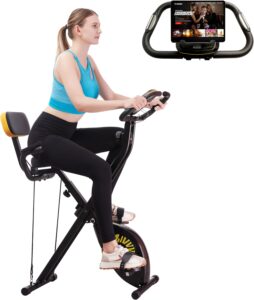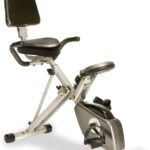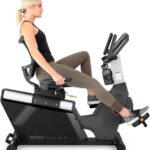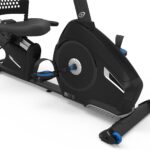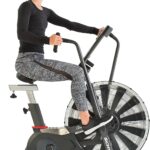One of the most effective cardio equipment, a stationary bike, is also a super user-friendly exercise machine that targets the whole body. You can burn a good amount of calories while riding reasonably on a stationary bike. However, to calculate the calories burned on a stationary bike, you must first calculate the distance covered. This is the foremost step to getting the best out of your workouts.
The cadence of a stationary bike is measured in both Revolutions per Minute (rpm) and Miles per Hour (mph). Many people find it easier to calculate the distance in miles. If you have been looking for ways to convert rpm to mph on a stationary bike , you have landed at the right place.
What is Revolutions Per Minute (rpm)?
RPM, an acronym for Revolutions per Minute, is the unit for measuring the rotational speed of the object. In literal terms, rpm means the number of complete turns a rotational thing takes in one minute.
How to Convert RPM to MPH on a Stationary Bike?
The first step for converting rpm to mph on a stationary bike is accurately calculating the diameter of the round around which the object rotates. In this case, you need to know the diameter of the wheel. The more the diameter, the more the circumference and the distance covered in one minute. Make sure you convert the units properly before starting to convert rpm into mph.
Follow these steps to convert stationary bike rpm to mph:
Step #1. Calculate the Circumference:
Firstly, after finding out the diameter of the wheel in feet, multiply it by 3.14, i.e., the value of pi. For example, if the diameter of the wheel of a stationary bike is 1.5 feet, the circumference of the stationary bike wheel will be 1.5 x 3.14= 4.71 feet.
Step #2. Find out the distance traveled per hour:
Once you have the circumference, calculate the distance traveled per hour on the stationary bike. For this, you need to multiple the rim obtained with the wheel’s rotational speed.
For Example;
If the rotational speed of the bike is 100 rpm, the distance traveled per hour would be 471 feet per hour.
Step #3. Convert the Distance into feet per hour:
Multiply the number by 60 to get the distance traveled per minute.
471 x 60 = 28, 260 feet per hour
Step #4. Convert into miles per hour:
Divide the number obtained by 5,280.
28,260 / 5280
The distance of the stationary bike came out to be 5.35 miles per hour.
The process is pretty simple and easy to calculate. Anyone can do this method without much brainstorming.
What is a good rpm on an exercise bike?
No rule of thumb tells about the excellent rpm on an exercise bike. However, an rpm of 50 to 100 is usually considered a good number. But this is more applicable to beginners. An rpm of up to 110 is regarded as a good number for the experts level fitness enthusiasts. Multiple factors decide the “right” or “good” rpm for a rider, such as resistance level of the bike, fitness level of the rider, fitness goals, etc.
As a rider, you can achieve three different speed levels on an exercise bike, i.e., light, medium, and fast.
- The light level ranges from 30 to 40 RPMs and works best for beginners as they face a minimal level of resistance at this speed. At the same time, the rider will burn the least number of calories at this level. Hence it’s most suitable for the elderly, people having joint problems, or recovering from injuries.
- The medium level ranges from 50 to 60 pm and is a bit intrusive for the rider as he faces a higher resistance than the light level. This is a good rpm on an exercise bike for those looking to step up from the beginner level.
- The high level reaches 70 rpm and is considered the fastest on an exercise bike. The rider faces the highest resistance and burns the most calories at this level.
Read: Is Exercise Bike Good for Knees
How Fast is 70 rpm on a Stationary Bike?
The speed of the stationary bike is also known as cadence. When measured in RPMs, it means the number of revolutions done by the pedal in one minute. Similarly, 70 rpm on a stationary bike means 70 revolutions per minute of the pedal. The bike’s speed at this rpm will be somewhere between 5mph to 25 mph. This might be a little faster for beginners or occasional riders.
How to Calculate rpm on the Stationary Bike?
Since rpm, in literal terms, is the number of revolutions a pedal completes in one minute, it is pretty easy to calculate. You can do it simply while riding the bike. Here is how;
1- Hop on your stationary bike and start pedaling. Attain a comfortable speed and resistance. You must cycle for a few minutes until you achieve a steady pace before calculating the rpm.
2- The next step is the crucial one and requires your attention. You have to consider the number of times your right foot completes one complete rotation in one minute. The number would lie somewhere between 60 and 100 pm.
3- Slow down and calculate the number of times your right foot completes one rotation in 15 seconds. Multiply this number by four, and you will have the rpm.
Tips:
- Your RPM must correspond to your fitness goals.
- When at a beginner level, start at a slower pace. With time, your strength and endurance will improve, and then you can step up your fitness goals.
- If you have any joint problems, you must consult your doctor before starting exercise on a stationary bike.
Read: How Do Exercise Bikes Calculate Calories
Key Takeaway:
A stationary bike is an excellent tool for indoor cycling that caters to different ages and fitness levels. It measures the speed in revolutions per minute (rpm) and miles per hour (mph). You can easily convert rpm to mph and vice versa. There are three different levels. It would be best if you chose according to your fitness levels as well as fitness goals.,
